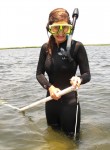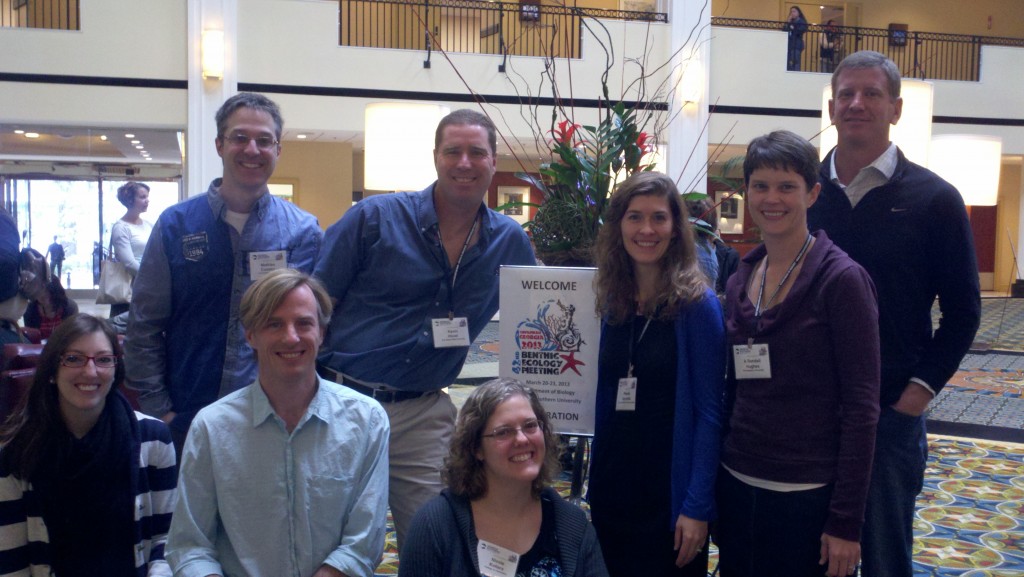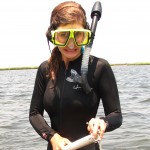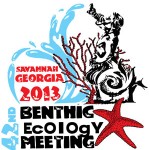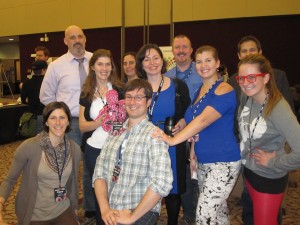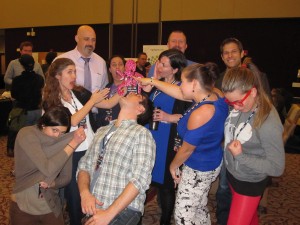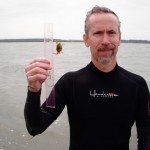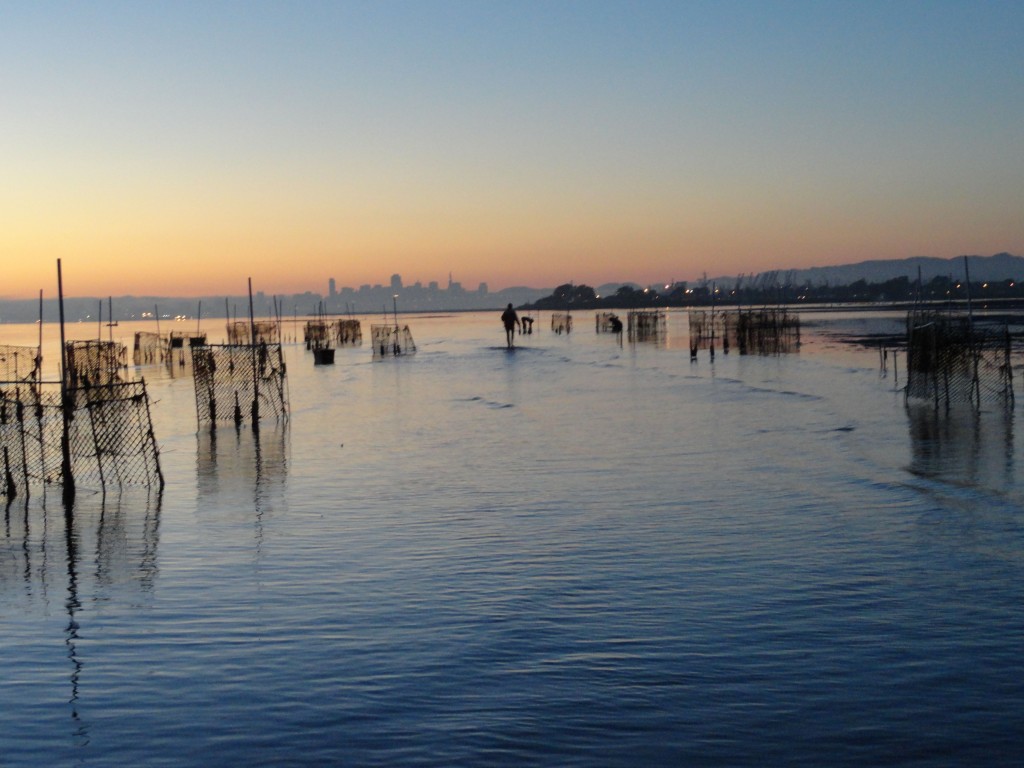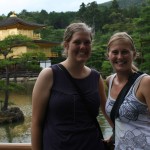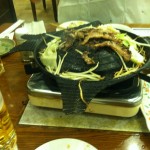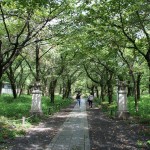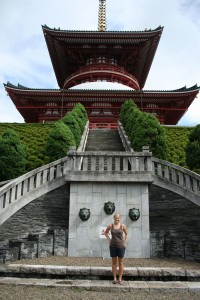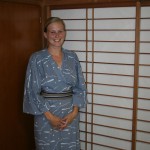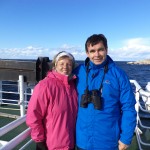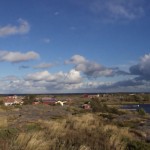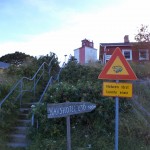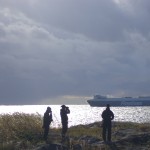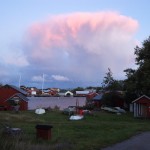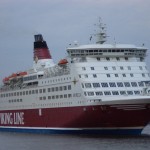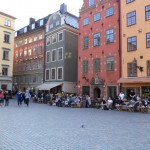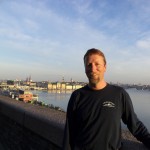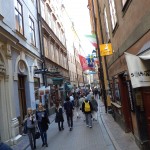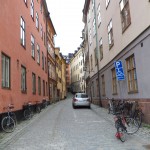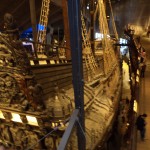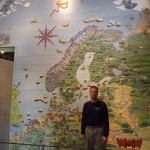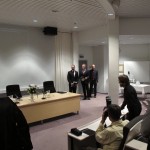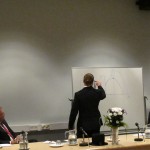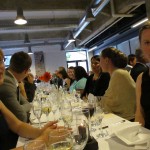ZEN Benthic Ecology Meeting 2013
by Pamela Reynolds (ZEN coordinator)
Meetings are wonderful excuses to meet up with old friends, make new ones, and, of course, talk science! Last week I presented some of the emerging results at the annual Benthic Ecology Meeting in Savannah, Georgia. The meeting was a great opportunity for many of the ZEN partners to network with each other and other attendees of the meeting, which focuses on marine ecology research along the East and Gulf coasts. Drs. Mathieu Cusson (Quebec), James Douglass (Massachusetts/Florida), Kevin Hovel (California), and Erik Sotka (North Carolina) were all in attendance, along with two new ZEN partners, Drs. Randall Hughes (Massachusetts) and Joel Fodrie (North Carolina), two of the ZEN student exchange fellows (Rachel Gittman, Nicole Kollars) and other grad students who have helped with the ZEN research (Jon Lefcheck, Laetitia Joseph). I was excited about the depth and breadth of talks, especially by those presented by the ZEN partners, which ranged from experiments on the role of functional diversity and salt marsh mutualisms, to whether crabs can hear and the effects of seagrass habitat fragmentation on epifauna. (See a full list of talks and abstracts on the BEM website) Additionally, our short music video “GRAZER” was one of 14 films chosen for the main Beneath the Waves Film Festival screening at the conference. I’ll post the film here shortly so check back.
GRAZER debuts at Beneath the Waves Film Festival
by Pamela Reynolds (ZEN Coordinator)
At the Virginia Institute of Science, we are gearing up for this year’s Benthic Ecology Meeting in Savannah, Georgia. We can’t wait to hear what our colleagues are up to, talk science, and watch the films at this year’s Beneath the Waves Film Festival.
Come to the festival on the evening of March 21st to watch our short film, titled “GRAZER”. This film was produced by the Marine Biodiversity Lab at VIMS and features contributions from the ZEN partners as well as undergraduates at the College of William and Mary. It’s our way of saying “thank you” to all of the hard working individuals who’ve dedicated the past two years with us to quantify the role of biodiversity and to understand top-down and bottom-up interactions in eelgrass beds. We’ll be posting the full video on ZENscience.org later this week, so check back!
To get you excited, here’s a short teaser…
Sci-Octopus
Six years ago, on a cold January morning, I attended a cozy gathering on the campus of UNC Chapel Hill of scientists, journalists and educators interested in utilizing online tools to deepen our activities and promote collaborations. Over the years I have watched the conference grow exponentially, encouraging conversation, community, and connections at the intersection of science and the web. This January boasted the largest yet ScienceOnlineConference in Raleigh, NC, and I had the opportunity to meet up with old colleagues, make some new ones, and sing more than one sea shanty. The Ocean Bloggers were by far the biggest (and loudest) contingent at the conference, and will be holding their own spin off SciOnline: Oceans conference in October. In addition to headliner talks by the social media specialists at the NASA Jet Propulsion Laboratory, and discussion on topics ranging from managing your online persona, ‘doing’ outreach and citizen science, to rethinking peer review and science deficits and denials, along with blitz sessions on everything from mobile apps for the lab to dog cognition – there was something for everyone to get involved in. Looking forward to SciOnline 2014, although next year I may opt for the SciOnlineLIVE version and even further embrace employing online tools to engage with the wider science community.

The conference had some great book giveaways. A colleague and I received copies of the R Cookbook, which will undoubtedly be useful for analyzing all the ZEN data that keeps coming in!
Duffy Receives Outstanding Faculty Award
It was announced today that Dr. Emmett Duffy is one of the 2013 recipients of the Virginia Outstanding Faculty Awards. This honor recognizes excellence in teaching, mentorship, research and service.
In response, Emmett says: “Receiving the Outstanding Faculty Award is of course a huge thrill for me. One reason is that it’s allowed me to spread the word about the ZEN partnership and project (see the College of William and Mary’s video here) and to highlight some of the cool things we’re doing. Honestly, I think ZEN is the most exciting science I’ve ever done, and we have our large group of motivated partners, and especially Pamela Reynolds, to thank for that. There will be more to come soon since we’re in the thick of data analysis and some intriguing results are emerging. Stay tuned!”
Winged Grazers Mow Down Eelgrass in San Francisco Bay
By Pamela Reynolds (ZEN Coordinator)
Here at ZEN, when we use the word “grazer” we typically mean the small crustacean and gastropod invertebrates that live on and eat the algae (and sometimes the eelgrass) at our estuarine field sites. But for our partners at the Romberg Tiburon Center For Environmental Studies in California, grazers come with webbed feet, a hiss and a honk.
In San Francisco Bay migrating Canada geese mow down eelgrass beds and may help drive the persistence of separate perennial and annual growth forms within the same bed, says laboratory technician Stephanie Kiriakopolos who studied Zostera marina life history traits for her master’s thesis under ZEN partner Dr. Kathy Boyer at San Francisco State University.
Want to see the geese in action? Check out this video from Stephanie, and the nifty cages the San Francisco ZEN team constructed to keep these winged grazers out of our experiments.
Thankful for my day job
by Pamela Reynolds, ZEN Coordinator
This past week in the States we celebrated the Thanksgiving Holiday, which encouraged me reflect on all that I am thankful for – family, friends, and great colleagues near and far!
Continuing along the theme of creative collaborators, a film recently sent to me from grad student Ross Whippo in ZEN partner Dr. Mary O’Connor’s lab at the University of British Columbia in Vancouver, Canada, reminds me what a great career I have as a marine ecologist. What does your lab do?
Science is Creative
by Pamela Reynolds, ZEN Coordinator
Coordinating the ZEN is awesome. Not only do I have the opportunity to interact with incredibly smart and wonderful researchers across the globe, but I am constantly impressed with their creativity and talent. From writing marine ecological haikus to crafting algae and sea creature art, the ZEN partners continue to surprise me.
Here’s a video recently sent to me by Eduardo Infantes, a postdoc with Per Moksnes’ who assisted with the ZEN projects this past summer in Sweden. This video produced by Eduardo shows how the Swedish team used the experimental protocols and materials we sent them from VIMS to implement an experiment testing for predator effects in eelgrass beds at their field site in Gullmar Fjord. The video features Drs. Moksnes, Johan Eklov and Lars Gamfeldt, and grad student Jonas Thormar at the Kristineberg Marine Station on the west coast of Sweden. Just think how much shorter and more exciting scientific papers could be if they all included links to online video methods with fun soundtracks like this!
I’ll let Eduardo and some of the other ZEN scientists tell you in more detail about the experiment (affectionately called the “Podsicle” approach) in another blog post. Until then, enjoy the movie!
North and South Unite! A 4-day epic adventure across Japan
by Nicole Kollars and Rachel Gittman (ZEN graduate student fellows)
With the lab processing finished in Akkeshi (see Rachel’s blog “Sayonara Hiroshima”) we said goodbye to our ZEN colleagues and began a whirlwind sight-seeing adventure of the Japanese countryside. We must confess that we were a little intimidated at first. We relied so much on our new friends to translate for us and explain Japanese customs that venturing out on our own to explore the country was a little scary. Equipped with a pocket dictionary, a few maps, and a Japanese rail pass we boarded the train at the Akkeshi station excited and full of anticipation for the sights and sounds that were ahead of us.
First-stop: Sapporo!
After a 5-hour train ride across the beautiful, green hillsides of Hokkaido, we made our first stop in Sapporo. Sapporo is the largest city on Hokkaido and is most famous for its breweries. That night we stopped at the Sapporo Beer Factory for a lovely feast of fresh lamb and vegetables that were brought out raw for us to cook over a heated grill right at the table. We enjoyed the delicious food and beverages while talking about our research, life as a graduate student, and our plans for the upcoming semester.
The next morning we toured the botanical gardens of Hokkaido University. It was a little late in the season to see the flowers in bloom, but the pathways through the woods were beautiful. However, we quickly learned that Rachel’s injured ankle was not up for the task. A few days before, Massa-san had taken us to the intertidal to show us the different types of eelgrass found in Akkeshi Bay. Rachel had twisted her ankle in the rocks and the squeezing of the waders we were wearing had only intensified the injury. We decided that the ankle definitely needed some doctoring before we continued our walking explorations, which was an adventure in itself. It took some trial and error in communication while asking for directions, but we finally made it to a drug store to buy wraps and bandages. Rachel looked forward to the upcoming train ride to rest.
A “Harry Potter” train ride
We were fortunate enough to have the opportunity for an experience that not many tourists enjoy – the 22-hour Twilight Express train ride from Sapporo to Kyoto. This train travels along the Sea of Japan down the entire coastline of the main island of Honshu. It was very difficult to get tickets for this train. It is popular among the Japanese during their vacation time and Hori-san had to be very insistent during a conversation with the booking agent to ensure we had reservations. We are so grateful for his effort! The coastline was spectacular, especially as the sun began to set. Our eyes were glued to the window as the train reached the more southern towns and villages. We had excellent accommodations for the journey in a shared compartment with room for 4 people. We shared the room with an older man who did not speak much English but was very kind and insisted that we see the “Golden Pavilion” when we stopped in Kyoto.
Temples, Bamboo, and Geisha
Kyoto is known as the cultural capital of Japan. We only had 20 hours to see as much of the city as possible and we did not waste a minute of it. After settling into our youth hostel and grabbing a quick lunch at the “ZEN Café” (!), we put on our sunscreen, grabbed our fans, and began walking through the city. The receptionist at the hostel mapped out a touring path for us and we were not disappointed. Our journey took us through a maze of temples, shrines, gardens and shops. In the evening, we ended up in the Geisha district of Gion and saw a Geisha cultural performance at a local theater. The show involved a traditional tea ceremony, harp-playing, dancing, and short plays. Dark had fallen while we were in the theater, and we walked out onto cobblestone streets lit by paper lanterns. After dinner in downtown Kyoto we made our way back to the hotel to ice our ankles swollen from a day of walking. Nicole also had an injured ankle from a sprain involving a slippery staircase a few weeks before.
The next morning we boarded the train for the western part of the city. There we explored a ZEN temple and garden that included a long grove of bamboo. The dense canopy of bamboo was magical and a highlight of our Kyoto experience! From there we ventured to the Golden Pavilion as recommended by our friend on the train. It was well worth the long walk from the train station, the temple was so dramatic in its intensity. After bowls of ramen noodles (these noodles were definitely not your typical college student’s ramen) and green-tea flavored soft serve ice cream, we caught the bullet train to Tokyo.
Our last 24 hours in Japan
With the speed of the bullet train we made it to Tokyo in just over three hours and just in time for rush hour. Our connecting train from Tokyo to Narita (where we would be staying for the night and where the airport was) was packed face-to-face. It took us nearly 2 hours of wading through a dense sea of people with gigantic luggage bags before we reached this outskirt of Tokyo. Exhausted, we both agreed to pay for a taxi to take us from the train station in Narita to our ryokan for the night. A ryokan is a hotel of traditional Japanese style and we slept on futons in a tatami matted room. Across from the ryokan was a beautiful suite of temples, shrines, and gardens – perfect for exploring the next morning before we had to leave the airport.
We arrived at the airport with 6 hours to spare. We wandered around the airport shops, had our last lunch in Japan, and re-pack our luggage to shove in all the extra souvenirs we were bringing back to our families and friends. Finally, it was time to go our separate ways – Rachel to San Francisco and Nicole to Los Angeles to catch connecting flights to our homes in North and South Carolina respectively. Grateful for the journey through Japan together and the friendship forged, we knew we would see each other again soon – whether it be at conferences, while visiting each other’s laboratories, or in another eelgrass bed.
Check out some more images from Nicole and Rachel’s last few days in Japan:
Exploring Finland’s Outer Islands
by Paul Richardson (VIMS technician)
If you’re ever in the Archipelago Sea of Finland, then you must visit the outer exotic islands. I took advantage of a few slow days before the experimental breakdown to take an overnight trip to Utö Island on one of the free boats that make regular rounds of these islands. Utö is an island on the outer archipelago with a town, a light house and an old military base that was used in battles with the Russians and others.
The boat I took, the M/S Eivor, is a refurbished Norwegian fishing vessel that is very sea worthy. It has a nice cafeteria, inside benches and seats and, my favorite part, the open air upper deck that is three stories above the water with diner style benches and tables.
The boat passed and stops at many islands along its five hour trip. It is nice to see all of the islands, but if you get off of the boat, you will be left until the next day. So, it’s good to bring an overnight bag for this trip and it’s also preferable to contact people ahead of time at whichever island you choose. I contacted Hanna Kovanen at Utö Island. She, like most everyone else that I met in Scandinavia, speaks fluent English. She’s very nice, and she’s a native of the island. When she was younger she went to California for a foreign exchange program. Hanna is a very bright multi-tasker in that she served as my tour guide, hotel clerk, and chamber of commerce minister once on the Island. The tour of the lighthouse was 6 Euros and my room was 25 Euros. As I said, the boat ride is free so this is a very inexpensive trip. Who said Scandinavia is too expensive to visit?
While on the boat I made some new friends, Antti and Tuula Karlin. Antti is an orninthologist and Tuula is a school teacher. They are native Finns. Antti was very surprised to meet an American and, like some others in Finland, he referred to me as “exotic”! Overall, my experience was that most Finnish people who speak English love to talk to Americans (like me!) and they’re all extremely kind. The Karlins were no exception and I genuinely enjoyed chatting visiting with them. We exchanged emails and we’ve been trading pictures and information ever since.
One interesting fact about Tuula is that she “collects” swimming holes. She goes swimming all over Scandinavia and other places, despite the temperature. She keeps a swimming journal with her collection of sites. When I saw her on the boat ride back on the next day she informed me that she went swimming at Utö. Meanwhile, I was wondering whether my sweater, long johns, hat, and jacket, were enough clothes for the frigid air temperature! Boy, I’m such a wimp when it comes to cold water!
Utö Island
I spent the night on Utö Island. It’s one of the outer most islands of the archipelago. It has a very rugged beauty and is steeped in a rich history. On the island there is an old military base, some weather stations, fishing shacks, plenty of beautiful vistas, a 19th century lighthouse and lots of history. The lighthouse that stands there now was built in 1814 – the original light house built in 1753 was blown up in the Finnish war. The island even has its own endemic toad. What they don’t have are ticks. Nice!
Connection to the United States
On Christmas Eve in 1947 a United States ship, the SS Park Victory, was just off of the Utö lighthouse trying to maintain its position in the icy waters when its boiler exploded and blew a hole through the side of the ship sinking it. Ten of the 148 men died and the other 138 were rescued by the people of Utö. They took them into their homes and gave them shelter and food. This was recognized by the U.S. government on at least two separate occasions and the letters are framed on the wall of the chapel in the lighthouse.
According to Hanna, this was the first time that the people of Utö ever saw a black person. According to personal accounts that Hannna referenced in her tour, there was some confusion among the black sailors when they entered the houses and found that there were no segregated tables where they could sit. This also created confusion for the citizens of Utö! Needless to say, all of the survivors were seated at the same tables. Hanna also indicated that she is related to one of these black survivors.
Off to Stockholm
The next day I got on the much larger (cruise ship size) M/S Isabella, which is a Viking Line “ferry” that carries some cars and mostly pedestrians from Turku to several ports at various locations within the 10 nations that border the Baltic Sea. My boat was headed to Stockholm, Sweden. It’s a pretty sweet deal, really. I paid 70 Euros for a round trip ticket. The ship picked me up at 8pm on Monday night in Turku. Once on board, I dropped my bag off in my cabin which was very nice with a private bathroom and fresh sheets. I then checked out the restaurants, casinos, discos, and the huge mall-like tax free shopping center, and then I went to bed. I’d walked all over Turku all day and so I was quite tired.
I awoke at 7am when the ship was approaching Stockholm. It amazed me how close the ferry went to the rocky shoreline. At several points, I could have easily tossed a baseball onto someone’s summer cottage. The ferry docked shortly thereafter and I had the whole day to explore Stockholm and I didn’t have to be back to the boat until 8pm. I walked all over the city. I inquired about the buses and trains and water taxis, but I chose to see a city on foot. Taking it slow allowed me to really see lots of cool details that I would have missed on the bus.
Stockholm is a very old, very beautiful capital city of 870,000, located on 14 islands in the south east of Sweden. The first thing that I noticed was the beauty. The second thing that I noticed was that there were literally more bikes than cars. There were so many of them flying down the hill as I walked into the old town, that I actually felt safer crossing the automobile road with its crossing lights than I did crossing the bike lanes! But I think it’s great! In the States, it’s the opposite. We have the tyranny of the automobile and good luck if you commute by bicycle.
I don’t have the data here to back it up but qualitatively, I’m sure that the Finnish and the Swedes are more physically fit than my fellow Virginian Americans thanks in part to the higher prevalence of bicycle usage. I didn’t drive a car for my entire 40 days in Scandinavia and instead rode a bike or walked, which is probably the reason that I lost 10 pounds during the trip. It was high school the last time I weighed so little!
The city was lovely and the main activity that I did while there, aside from eating and walking, was my visit to the Vasa museum. The Vasa is a one of a kind attraction. In 1628, the king of Sweden, Gustavus Adolphus, in his haste, launched the state of the art warship, Vasa to send to Poland to fight in some Catholic Protestant battles. At 226 ft long and 172 ft tall with 36 guns (twice the recommended amount) and fatefully, not enough ballast, the top heavy vessel floundered and sank near her railway on her maiden voyage. In the absence of ship worms and the presence of anoxic conditions resulting from the pollution in the harbor, the ship was nearly perfectly preserved.
In 1961 archeologists knew that the Vasa laid somewhere in the harbor and so they started taking cores of the sediment to see if they could get a plug of some white oak which is the wood that the Vasa was made of. After many attempts, they finally located and excavated her. Using SCUBA and some type of fire hose pump they insert several harnesses under the hull and ultimately hoisted the behemoth, nearly intact, to the surface. They’ve been restoring her ever sense.
The thoroughness of the museum was simply mind boggling. I spent three hours there and I could only scratch the surface. It is six stories from the keel to the top deck. They had to replace all of the water in the wood with polyethylene glycol. There were skeletons of the people who were on board and perished in the disaster. There were models, and maps and MRIs of the hull. In some ways it almost resembled a modern ship yard with lifts and heavy equipment and restorers flitting around working. There were so many exhibits with artifacts that it was overwhelming. By 1pm I was quite hungry and I needed to see sunlight again. I had intended to get some food and return, but when I went outside it was so beautiful that I vowed not to go into any more museums! I spent the rest of my day in Stockholm sightseeing and taking tons of pictures. Towards the latter part of the day, close to the time when I would catch the ferry, I went from pub to pub trying various delicious food and beverages.
As I got on the ferry in Stockholm on Tuesday night I received a phone call from Christoffer. He wanted to warn me that I must come directly to the lab and prepare for the field on Wednesday as soon as I got back from Turku. We would go to the field that afternoon and begin the ZEN breakdown since there was very bad weather predicted for Friday. My mini-vacation was over and it was time to get back to work on this last phase of my involvement with the ZEN project in Finland.
A Dissertation Defense, Finish Style
by Paul Richardson (VIMS technician)
After many years of graduate school, students are expected to defend all of the work they’ve done before they receive their degree. Doctoral defenses in the States are pretty intense and generally consist of a public lecture followed by public and private questioning session that can last for hours. I’d been told that European defenses can be much more elaborate and so, when I heard that one was scheduled for a Finnish student here at Åbo Akedemi I decided that I must go! Camilla, a graduate student here helping with the ZEN work, invited me with the instructions to bring my dress pants and dancing shoes. And my new Swedish language skills as the defense would not be in English. So, I woke up early and rode my borrowed bike in my dress pants with my backpack the 10 km to the little town on Korpo Island to catch the bus for the two hour ride to Åbo Akedemi’s Bio City in Turku.
Once I got to Turku I went to the Domis, which is Åbo Akademi University’s housing for guests. The Domis is a very Spartan grey concrete institutional building with more locks that Fort Knox (a military base in the USA). Once I penetrated the outer perimeter I met the very friendly Anita Bruman Tott who checked me in. One of the first things I recall her asking me was, “hey, are you the TV guy?” I guess my cameo on the Finnish TV talking about seagrasses has made me slightly famous here!
The fee for staying at the Domis was quite reasonable at 30€. It turns out the room was just as Spartan as the rest of the building and the bathroom was a little cramped, but the bed was very comfortable, the view was pleasant, and later that night, I slept like a baby.
Since the defense was a formal affair, I recognized that I was grossly underprepared in the wardrobe department The only suit I’d brought with me was my wetsuit and, despite the fact that we are marine ecologists, showing up to the defense salty and smelly probably wasn’t the best way to go, even if it would have been funny (and uncomfortably hot!). Christoffer let me raid his closet and I came up with a tie and a slightly too small sport jacket. In need of a dress shirt, after checking into Domis I went straight to the mall. The salesman had a good laugh when I came out of the dressing room with the brand new shirt on (with all of the tags still attached) under the tie and sport coat. He cut the tags and rang me up.
All dressed up I headed downtown toward Bio city, grabbing a snack along the way as I had been warned that the defense would take several hours. Realizing that the defense would be starting soon, I picked up the pace. Camilla called me and, after asking where I was, told me to quickly get on a bus as I wouldn’t make it in time. They are very punctual here in Finland and if I was even a minute late I risked being locked out of the “proceedings!” So, I backtracked quickly to a bus stop and crossed my fingers that the first bus I hopped on was the most direct one to the university.
Thank goodness for the effective mass transit of Turku! , I made it just in time. The door closed right as I sat down. Right away, three well groomed gentlemen walked inside wearing very nice suits – one even had a top hat! Everyone in the auditorium stood. We stayed standing until someone gave a signal to sit and everyone sat in unison. I started to wonder – is this a dissertation defense or a court of law? Cameras started clicking away, preserving this momentous occasion, and so I went to get mine. That’s when I realized that I’d left it on the bus! That was bummer. Luckily Camilla had a camera and shared her photos with me.
Before I forget, the student defending his defense was Matias Scheinin. His advisor, Johanna Mattila, was wearing the top hat. The third gentleman was the “challenger,” an external reviewer flown in to test the student’s knowledge, from Sweden, Peter Eklöv.
After introductions, Matias launched into the formal hour-long presentation of his work on the “Patterns and processes of littoral zooplankton composition in relation to the trophic state of the environment.” The defense was in Swedish, but luckily for me, the presentation slides were in English. His work on the zooplankton ecology of the Baltic was very interesting. One of his experiments involved natural mesocosms, which consisted of coves in islands (called flads) that had varying communities with varying levels of predation by different fishes including roach (Rutilus rutilus) and perch (Perca fluviatilis). The take home message from that experiment for me was that differences in vegetation (presence or absence of submerged aquatic vegetation) affected the feeding rates of perch, but did not affect roach feeding. I’d seen a lot of roach around the docks at the field station, so it was very interesting to learn more about their ecology.
After the formal presentation the challenger, Peter Eklöv, critiqued Matias’ dissertation for the next two and half hours in front of the entire audience! This was very different from the defenses I’d seen back in the States where the professors grill the student in a closed door session after the public presentation. All of the interrogation was in Swedish, so it was difficult for me to follow. Eventually the whole thing was adjourned and we went to begin the celebrations – Matias had passed the exam and was now going to be a PhD!
In close vicinity to the auditorium the toasts began. In English we say cheers, but in Swedish they say skål (pronounced skole or skull). Then everyone dispersed and met back at the reception hall a few hours later. At the reception there was another toast outside in the lavish entry lobby and then, once again, the well-dressed crowd walked in and stood behind their chairs until given the signal to sit and the toasts resumed. Then there was an introduction to the buffet menu, which included rostad sik med pepparratssmörsås och honungsrostad rödbeta (roasted whitefish with peppercorns and honey roasted beetroot) for the main course and a wonderful äppelpaj med kardemummås (apple pie with cardamom) for dessert. Dessert was served with a selection of Scotch whiskies and cognacs and coffee, plus many more toasts, roasts, skits and power point presentations. Matias experienced a thorough hazing, all in good humor of course.
After dinner Matias’ brother-in-law and his all physician rock band played many great tunes ranging from the Rolling Stones, to Parliament, to Alanis Morrissette interspersed with very good Finnish rock songs (I couldn’t understand the words but they totally rocked!). Ultimately things wound down around 1:30 AM . While the others headed off to the “after-party” celebrations, I carried my old bones back to my Domis room to sleep.

